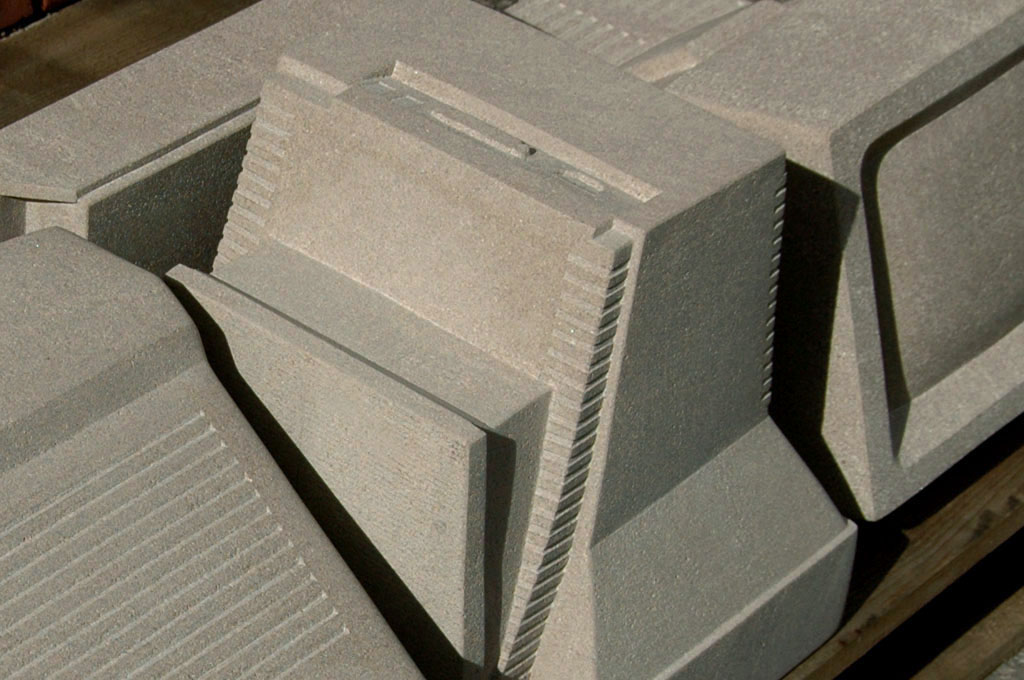We put computers out on the curb like junk. It’s one of those concepts that teeters on the edge of futurism; what would have been unthinkable twenty years ago, today verges on the mundane.
Technology begins to expire as soon as it is produced. When you buy a computer, speaker system, video player, or hard drive, the depreciation is immediate – the forward march of innovation means that their worth immediately begins to decay. These cast-off pieces of technology, once the very symbols of invention and ingenuity, become strange ghosts, forlorn testaments to the exponentially increasing rate of progress.
Sculptor Laura Moore’s current installation at grunt artist-run centre, one man’s junk, takes these forgotten castaways and turns them into something permanent, immemorial, timeless. Moore says that her choice of limestone for this series, as well as her interest in stone as a medium in general, has to do with its status as history-keeper for the human race. “Before cameras and electronics,” the artist says, “people told their stories in stone and sculpture…It’s a material that I think is really important historically.” As a member of an artists’ studio in Italy, Moore was inspired by the ancient sculptures and monuments there, in that country that has such a familiar relationship with the preserving of stories in stone. Although at first, she says, she was interested in carving electronics for chiefly aesthetic and geometrical reasons, she quickly became interested in the juxtaposition of a material old as the Earth itself and a subject matter that is from its start meant to break down.
As soon as Moore started experimenting with carving stone, she knew she had found her medium. She describes it as “the first thing that came really naturally.” The idea for this specific exhibit began when Moore was wandering on foot around her native Toronto. As she crossed a pedestrian overpass, she noticed an old computer monitor that had been flung to the ground below. “For me, that moment kind of marked something,” she says. Struck by inspiration, she spent the next few months biking around the city, looking for other examples of abandoned machines. When she found a suitable piece, she would photograph it, then transport the object back to her studio, where, she says, she still has dozens stockpiled. In this way, the sculptures that make up this exhibit could be described as portraits: likenesses of actual discarded objects, rather than generic outdated models.
one man’s junk represents a logical progression in Moore’s own body of work. In her initial phase of carving electronics, she was interested in the intricate, city-like shapes of circuit boards; her earlier works have included a huge limestone computer mouse and similarly scaled-up computer keys. Both were installed in outdoor settings, to catch casual passers-by off guard. Moore’s fascination with technology took a slightly different bent in Kernel Memory, an installation currently on the lawn of the Saint Catherine’s, Ontario City Hall. After becoming “very obsessed with USB memory sticks,” Moore became fascinated with the idea of where they would naturally occur in nature. “They connect to everything,” she says. “They would be…your fingernails, the stems of fruit.” She combined them with another aesthetic fascination, acorns and pinecones, to create a series of 9 nature/tech hybrids proportionally upscaled from inches to feet.
“We put computers out on the curb like junk. It’s one of those concepts that teeters on the edge of futurism; what would have been unthinkable twenty years ago, today verges on the mundane.”
Where the Sidewalk Ends, a 2007 installation that shares with one man’s junk a slightly humorous title, provides a prime example of the deceptive relationship in the artist’s work between labour and simplicity. Upon first seeing the exhibition, one could hardly imagine anything more minimal – a series of curbs, just like the ones that hold cars in place on the street, line the edges of a “white cube” gallery space. A similar simplicity informs the first impression of one man’s junk – the pieces are stacked, grouped all together on a wooden pallet. What Moore accomplishes with these installations is that artist’s trick of “making it look easy” – that is, the smooth, almost computerized looking surfaces belie the many hours of physical labour that went into revealing them from unrelenting chunks of stone. In the case of the curbs, not only did Moore carve them by hand, rather than casting them as one might guess, but she specifically re-sized them to four feet from eight, in order to hold two people, instead of two cars.
Throughout Moore’s work can be seen a carefulness, a quietness; a sense of concern and appreciation for the minutiae of everyday life. By coming upon a scaled-up computer mouse or escape key in the street, one hopes that the viewer could as well come to appreciate the beauty of these tiny forms. By giving a pallet of discarded electronics your appreciation in a gallery setting, we are redirecting our attention to these forgotten objects – elevating and exonerating that which has done the brute work of transmitting our data and preserving our stories. That which, for all its technique and innovation, inevitably becomes nothing but one man’s junk.
About Genevieve Michaels:

Genevieve is studying art history and creative writing at the University of British Columbia. She has been volunteering at grunt since last October, writing and assisting with maintenance and digitization of the archives. She also writes about music and city life for local magazine Beatroute BC. Follow her on twitter: @LavenderIndigo0


